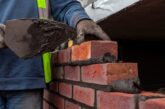
Kevin Brannigan, Marketing Manager at Makita, outlines the benefits of cordless tools for hard landscaping work and highlights some of the products that professionals should consider.
The conventional wisdom is that the demanding nature of hard landscaping tasks, especially when concrete elements are involved, means the power of petrol or mains corded machines is required. However, advances in cordless technology, and in particular the development of more powerful 40 Volt and 80 Volt platforms, has meant this is no longer the case. There are now a wide range of cordless tools that offer performance comparable to petrol and corded and, in fact, can offer advantages over petrol and mains power.
Firstly, cordless tools are quieter and have lower vibration levels than petrol versions, reducing the long-term risks of hearing damage and Hand Arm Vibration Syndrome (HAVS). There is also a further safety benefit as eliminating the need to store and transport petrol means a reduced fire risk. Battery powered tools are also generally lighter than petrol equivalents, making them easier to use and reducing user fatigue.
Furthermore, with many trade businesses looking to minimise their environmental impact, moving away from petrol in favour of battery powered tools can help reduce the carbon emissions associated with fossil fuels.
When compared with corded tools, cordless provides much better flexibility and ease of working as there is no need to secure a nearby power source. The removal of cables from the work area also improves safety as it eliminates a potential trip hazard that must be managed.
Tools for hard landscaping
There are several specific tasks that have been traditionally dominated by petrol and corded tools where there are now high-performance corded options.

Concrete and stone cutting and breaking
One of the most common misconceptions around cordless tools is that they are not suitable for cutting and breaking tasks. However, there are now cordless disc cutters that offer the power and performance to efficiently cut stone and concrete, whether removing existing elements or cutting new materials to shape. For example, the Makita CE004G 40VMax Disc Cutter XGT, which has a 305mm blade that delivers a 121mm maximum cutting depth, is ideal for typical landscaping uses.
Perhaps one of the most demanding applications is breaking up concrete and as such has traditionally been the domain of mains powered machines. However, there are tools such as the HM004G 80VMax (2 x 40VMax) Breaker XGT, which can match the performance of corded alternatives with 72.8 joules of impact energy at a rate of 870 blows per minute (bpm). These machines can also be used for trenching by attaching a clay spade or for compacting soil by fitting a rammer.

Post hole boring
Whether for fencing or anchoring other garden structures, digging holes for posts is quicker and more efficient with an earth auger. But with soil conditions varying significantly from site to site, the machine needs have the power to deal with even the heaviest material. As an example, the DG001G 40VMax Earth Auger XGT delivers power equivalent to a 36cc petrol alternative.

Timber cutting
Many landscaping jobs will include elements of timber construction, whether that’s decking, pergolas, gazebos, retaining walls or raised beds. That is why having a high performance saw to hand is valuable. In the past, it would have needed to be a corded circular saw to deliver the power required to cut larger thicknesses, especially hardwood.
However, there are cordless 40VMax circular saws with blade diameters of 270mm, giving a cutting depth of 101mm and the power required to efficiently cut all types of wood as well as cordless 40VMax mitre saws with 216mm, 260mm or 305mm diameter blade options to provide even larger accurate cutting capacities. It may also be worth looking for a saw that is directly compatible with guide rails as this will help ensure accurate cuts every time with minimal effort.

What to look for when choosing cordless tools
As any professional will know, not all tools offer the same level of quality, performance or functionality. The first factor to consider when investing in cordless replacements for petrol or corded machines is the range of products available on that battery platform. Choosing tools with a shared battery platform simplifies work by minimising the number of different batteries and makes it easy to swap between different tools as required throughout a day’s work.
For example, the XGT range designed for those more demanding tasks where greater cordless power is needed, has over 100 products across 40VMax and 80VMax including drills, drivers, saws, grinders and demolition tools as well as a wide range of garden and grounds maintenance tools.
Another feature to look for selecting cordless tools is brushless motors. These high efficiency motors deliver more power and longer runtimes by eliminating wasted energy. In a conventional brushed motor, the contact between the carbon brushes and the commutator within the motor creates friction and heat, which reduces the battery power that can be used to drive the tool. In fact, in some cases brushless motors can extend run times by up to 50%. Also, tools with brushless motors require less maintenance throughout their life as there is no need to replace the brushes as they become worn.
In contrast to what is often assumed, cordless tools are now more than capable of matching the power and performance of petrol and mains powered versions for many landscaping tasks. Cordless power also offers further safety, flexibility and environmental benefits, making these tools the ideal solution.
To find out more about Makita’s XGT range of 40VMax and 80VMax tools visit www.makitauk.com.







